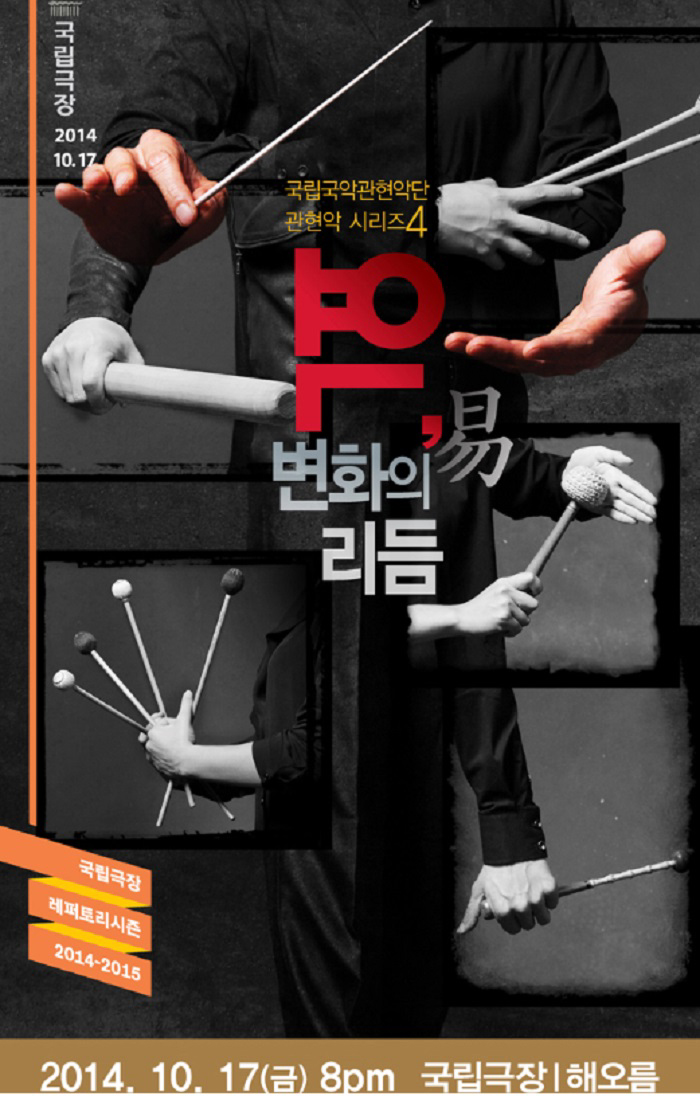European classical music will meet with the traditional sounds of Korea, or gugak, to combine and create something new.
The harmonious sounds of the two different genres will ring out at the National Theater of Korea for a special performance, titled “Reverse (易), Rhythms of Change,” on October 17.
The “Reverse (易)” in the title means “change,” with the philosophy stemming from China’s Eastern or Oriental thought.

The inspiration for the upcoming show began when the theater became aware of the need to make some changes in the National Orchestra of Korea's current repertoire.
“We prepared the show in an effort to add some twists to the classical tunes to which the orchestra has stuck, as well as to try out a new type of music that lives up to the demands of the times,” said an official from the National Theater of Korea.
The “Reverse (易), Rhythms of Change” performance features five variations where traditional beats will be emotionally mixed with classical music. The highlight is the orchestral piece “Bolero” composed by Maurice Ravel (1875–1937). It has been merged with tunes created by artistic director Won Il on the semachi jangdan rhythmic pattern, a musical beat that consists of three sets of three-beat measures. The so-called “Semachi Bolero,” a reinterpretation of Ravel’s masterpiece, may come as a breath of fresh air to music lovers of both genres.
In addition to this, composer Hwang Ho-jun will present in the show his recomposed “Shinmodeum,” a concerto played on traditional percussion instruments, also one of the pieces from the National Orchestra of Korea’s repertoire. Composer Park Jung-gyu’s new creation, “TOCCARE,” will be played by percussionist Han Moon-kyung.
A daechita, a troupe that would perform traditional music during royal palace ceremonies and rituals during Joseon times (1392-1910), will be brought back to life with added orchestral sounds. The “Concerto for Samulnori: Spirit,” a concerto composed with modern compositional techniques and based on samulnori, a style of traditional percussion music, will wrap up the show.
“The performance attempts to reinterpret and twist the rhythms, a fundamental element of music, in a variety of ways,” said an official from the National Orchestra of Korea. “The show is part of our effort to always find something new in music, instead of being stuck in one genre, all while maintaining our identity.”
By Lee Jeong-rok, Sohn JiAe
Korea.net Staff Writers
jeongrok@korea.kr
The harmonious sounds of the two different genres will ring out at the National Theater of Korea for a special performance, titled “Reverse (易), Rhythms of Change,” on October 17.
The “Reverse (易)” in the title means “change,” with the philosophy stemming from China’s Eastern or Oriental thought.

The official poster for the “Reverse (易), Rhythms of Change” concert, to run at the National Theater of Korea on October 17. (photo courtesy of the National Theater of Korea)
The inspiration for the upcoming show began when the theater became aware of the need to make some changes in the National Orchestra of Korea's current repertoire.
“We prepared the show in an effort to add some twists to the classical tunes to which the orchestra has stuck, as well as to try out a new type of music that lives up to the demands of the times,” said an official from the National Theater of Korea.
The “Reverse (易), Rhythms of Change” performance features five variations where traditional beats will be emotionally mixed with classical music. The highlight is the orchestral piece “Bolero” composed by Maurice Ravel (1875–1937). It has been merged with tunes created by artistic director Won Il on the semachi jangdan rhythmic pattern, a musical beat that consists of three sets of three-beat measures. The so-called “Semachi Bolero,” a reinterpretation of Ravel’s masterpiece, may come as a breath of fresh air to music lovers of both genres.
In addition to this, composer Hwang Ho-jun will present in the show his recomposed “Shinmodeum,” a concerto played on traditional percussion instruments, also one of the pieces from the National Orchestra of Korea’s repertoire. Composer Park Jung-gyu’s new creation, “TOCCARE,” will be played by percussionist Han Moon-kyung.
A daechita, a troupe that would perform traditional music during royal palace ceremonies and rituals during Joseon times (1392-1910), will be brought back to life with added orchestral sounds. The “Concerto for Samulnori: Spirit,” a concerto composed with modern compositional techniques and based on samulnori, a style of traditional percussion music, will wrap up the show.
“The performance attempts to reinterpret and twist the rhythms, a fundamental element of music, in a variety of ways,” said an official from the National Orchestra of Korea. “The show is part of our effort to always find something new in music, instead of being stuck in one genre, all while maintaining our identity.”
By Lee Jeong-rok, Sohn JiAe
Korea.net Staff Writers
jeongrok@korea.kr